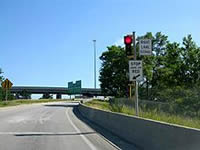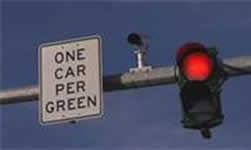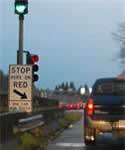FHWA Localized Bottleneck Reduction Program
Case Study
Printable Version [PDF 231KB]
You may need the Adobe® Reader® to view the PDF on this page.
Contact Information: Neil Spiller at Neil.Spiller@dot.gov
Location – Madison, Wisconsin



In Madison, five on-ramps along a four-mile section of Highway 12. (Generic ramp meters shown here)
Problem – Highway 12 showed crashes and delays at certain locations
Three interchanges with Highway 12 were chosen: Whitney Way (EB ramp), Fish Hatchery Road (two WB ramps), and Park Street (two WB ramps).
Solution – Install ramp meters
Ramp meters break up the on-ramp platoons that are released when a signal goes from red to green. This is called "access rate reduction", or more plainly, the opportunities for single cars to merge are better than for platoons to bull their way into traffic.
Several alternative solutions were considered, including geometric re-alignments. Ramp metering was selected because 1) it could be implemented more rapidly, and 2) it was a fraction of the cost of other alternatives, some being very expensive construction projects. WisDOT also took the opportunity to deploy these locations as a pilot test.
Two evaluation efforts were conducted; one by the University of Wisconsin, and the second by a transportation consulting firm using a regional travel demand model and the U.S. DOT's ITS Deployment Analysis System (IDAS) software tool.
Both evaluations found the ramp metering provided significant benefits and were deemed an effective strategy in reducing congestion and congestion-related accidents.
The most significant challenge was related to public education and public acceptance. Although many Madison residents were familiar with the concept elsewhere (they have driven in Minneapolis, Chicago, Milwaukee, et al) many others were not. The public was skeptical it would work "here".
Lesson Learned
Ramp meters work in candidate locations. Public surveys "after" yielded positive responses. Drivers not only gave high marks to the ramp meters (ranging from 78 to 92 percent acceptance) but they also reported "seeing" improved highway service. Compliance was observed to be 85 to 98 percent. The meters improved freeway speeds from 2 to 10 percent.